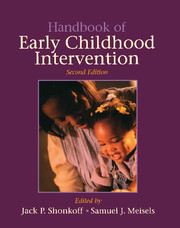Book contents
- Frontmatter
- Contents
- Foreword
- Preface
- Contributors
- PART ONE INTRODUCTION
- PART TWO CONCEPTS OF DEVELOPMENTAL VULNERABILITY AND RESILIENCE
- 2 The Biology of Developmental Vulnerability
- 3 Adaptive and Maladaptive Parenting: Perspectives on Risk and Protective Factors
- 4 The Human Ecology of Early Risk
- 5 Cultural Differences as Sources of Developmental Vulnerabilities and Resources
- 6 Protective Factors and Individual Resilience
- PART THREE THEORETICAL FRAMEWORKS FOR INTERVENTION
- PART FOUR APPROACHES TO ASSESSMENT
- PART FIVE SERVICE DELIVERY MODELS AND SYSTEMS
- PART SIX MEASURING THE IMPACT OF SERVICE DELIVERY
- PART SEVEN NEW DIRECTIONS FOR THE TWENTY-FIRST CENTURY
- Name Index
- Subject Index
6 - Protective Factors and Individual Resilience
Published online by Cambridge University Press: 05 November 2011
- Frontmatter
- Contents
- Foreword
- Preface
- Contributors
- PART ONE INTRODUCTION
- PART TWO CONCEPTS OF DEVELOPMENTAL VULNERABILITY AND RESILIENCE
- 2 The Biology of Developmental Vulnerability
- 3 Adaptive and Maladaptive Parenting: Perspectives on Risk and Protective Factors
- 4 The Human Ecology of Early Risk
- 5 Cultural Differences as Sources of Developmental Vulnerabilities and Resources
- 6 Protective Factors and Individual Resilience
- PART THREE THEORETICAL FRAMEWORKS FOR INTERVENTION
- PART FOUR APPROACHES TO ASSESSMENT
- PART FIVE SERVICE DELIVERY MODELS AND SYSTEMS
- PART SIX MEASURING THE IMPACT OF SERVICE DELIVERY
- PART SEVEN NEW DIRECTIONS FOR THE TWENTY-FIRST CENTURY
- Name Index
- Subject Index
Summary
It is man's role in this evolving universe to teach the terrors of his nature and his world to sing.
Lillian Smith, The JourneySince the publication of the first edition of The Handbook of Early Childhood Intervention, a rapidly growing body of literature dealing with the phenomenon of resilience and the role of protective factors in the lives of individuals who were born and raised under adverse conditions has appeared (Werner, 1990, 1995). Most research in this area has focused on short-term studies in middle childhood and adolescence. There has also been a growing interest in the life histories of adults who managed to overcome a cruel past successfully. Published accounts are usually retrospective or based on clinical samples (Higgins, 1994; Rubin, 1996). Surprisingly, despite the current popularity of the term resilience, relatively few prospective longitudinal studies have examined this phenomenon in infancy and the preschool years.
A lively debate has taken place over conceptual issues, centering on whether resilience is a state or trait, whether successful coping in the face of adversity is domain specific, and what the psychic costs are for at-risk children who manage to grow into competent, confident, and caring adults (Klohnen, 1996; Luthar & Cushing, 1999; Luthar & Zigler, 1991; Masten, Best, & Garmezy, 1990; Rutter, 1994; Zimmerman & Arunkumar, 1995). Some of these issues can be clarified by focusing on the few longitudinal studies that have examined resilience as a transactional process between the child and his or her environment.
- Type
- Chapter
- Information
- Handbook of Early Childhood Intervention , pp. 115 - 132Publisher: Cambridge University PressPrint publication year: 2000
- 269
- Cited by

